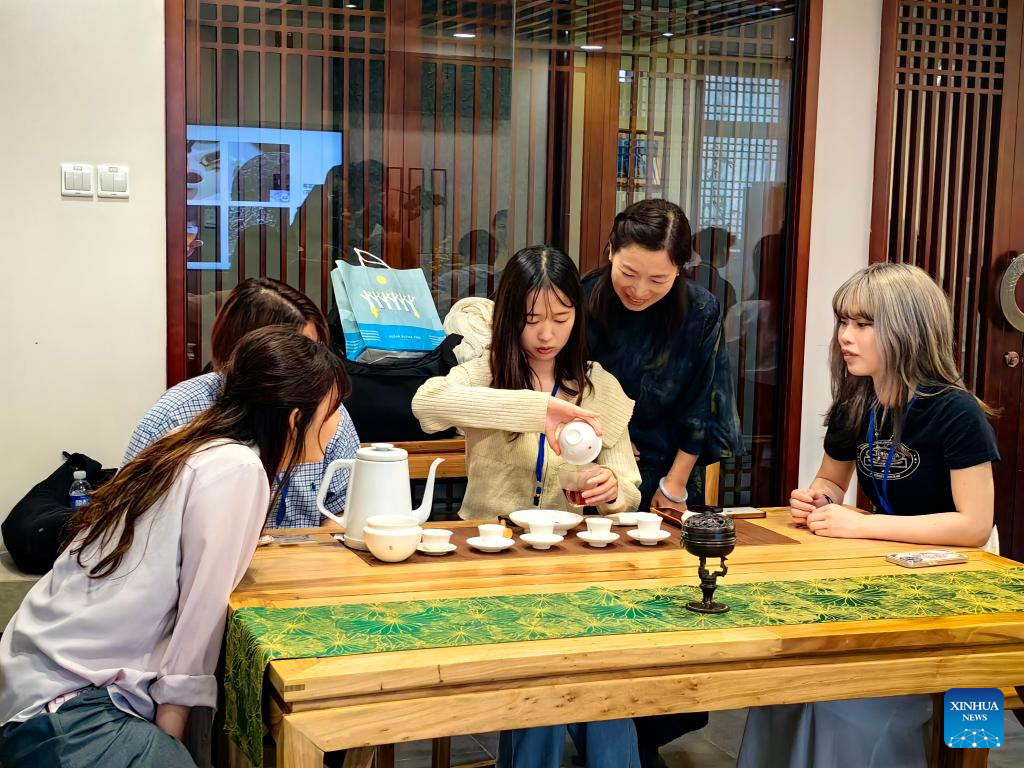
Shiroko Junna (1st L), a "post-2000" Japanese woman from Tokyo, learns to make Chinese Pu'er tea together with Japanese youths in Beijing, capital of China, Sept. 7, 2024.(Xinhua/Zhai Xiang)
BEIJING, Sept. 17 (Xinhua) -- The night before leaving Beijing, 19-year-old Japanese university student Matsufuji Aimi went shopping in Wangfujing with several companions. Dolls, osmanthus oolong tea-flavored sandwich cookies, Shaoxing rice wine and more. An hour later, her canvas bag was filled with goods she and her friends had chosen.
Her bag is adorned with "A Thousand Li of Rivers and Mountains," the famous landscape painting characterized by the depiction of blue and green colors. The painting is attributed to 18-year-old genius Wang Ximeng during the Song Dynasty (960-1279).
"This painting captures the majestic feeling of the continuous mountains, and realizing that the artist who created this Chinese national treasure was about my age makes me wonder about the life he led," said Matsufuji, who plans to use this bag for her commute to school after returning to Japan.
"The biggest difference in shopping between China and Japan is that you can pay with a QR code. A Chinese friend told me that it has been three years since she last used cash, which to me is unbelievable," said Matsufuji. She found the brightly lit cityscape of Shanghai stunning and glamorous, even more developed than Tokyo, while in Beijing she almost gave up while climbing the Great Wall, but thinking of the ancient Chinese gave her renewed strength which enabled her to reach the top.
"China is a place where tradition and innovation blend, and at different locations in China, you can see their unique characteristics," she told Xinhua.
This month, at the invitation of the Chinese People's Association for Friendship with Foreign Countries, four Japanese youth delegations visited China, adopting different themes and routes. Some visited Shaolin to experience Chinese kung fu, while others went to the Shanghai Museum, Sanxingdui, the Great Wall, and the Forbidden City to witness the depth of Chinese civilization. Another delegation explored the Museum of the Communist Party of China (CPC) and Olympic venues, tracing China's modernization journey. The remaining delegation entered universities such as Tsinghua and Beijing International Studies University (BISU) to interact with their Chinese peers.
Close to 400 Japanese youths participated in this initiative -- the majority of whom were born after 2000 and were visiting China for the first time. Matsufuji was part of this initiative and this trip was the first time she had traveled outside Japan.
"CONFUCIAN TEACHINGS READILY ACCESSIBLE IN CHINA"
On the flight from Shanghai to Shandong, Manoa Arai, a student at Chuo University majoring in Chinese language and culture, was pleasantly surprised to find excerpts from "The Analects of Confucius" decorating the cabin. Shandong Airlines has, since 2017, adorned every aircraft with 16 selected passages from "The Analects."
"In Japan, most people study 'The Analects' in high school," said Arai, noting that the encounter with an excerpt she studied at school had warmed her heart. "It made me realize that Confucian teachings are readily accessible in China," she added.
"I love this country and had a wonderful time," said Murakami Miku, a student of German literature at Sophia University, who found that the Confucian quotes provided new inspiration to her, a scholar typically engaged with German philosophers like Hegel. "Confucius' words are full of philosophical depth, allowing me to examine myself more objectively and become more productive."
At BISU, Gakushuin University student Hayakawa Nazuna donned Peking opera attire to experience the art of sleeve dancing. She expressed a desire for more such opportunities in the future. "Japan and China have various historical exchanges, and many elements of Japanese culture also originate from China. I want to experience the culture created by ancient Chinese and the culture that influenced Japanese culture, to feel the exchange and history between China and Japan," Hayakawa said.
Sajiki Mai from Kaichi International University, born into a family that has practiced calligraphy for three generations, came to China based on her calligraphy teacher's recommendation. "Many ancient buildings still stand, showing the importance people place on preserving fine traditional culture," Sajiki noted, expressing her hope to return to China to witness and study famous Chinese calligraphy steles firsthand. "Seeing Chinese stone monuments is a dream for students studying calligraphy in Japan!"
"A week is long enough to get accustomed to life in China, and now that I am returning to Japan, I feel reluctant to leave," said Ueda Haruhi, a ceramics major at Aichi University of the Arts. Her professor holds the history and techniques of porcelain making in Jingdezhen in high regard, which has made her even more eager to visit there. "Next time I come to China, I hope to go to Jingdezhen. I am interested in studying there!"
"I DEEPLY FEEL THE POWER OF CHINA"
Wang Yifan, a graduate student at Beijing Foreign Studies University, was struck by the enthusiasm of some Japanese youths for new experiences in China. "While climbing the Great Wall, one student showed me her mobile payment screen while saying that 'last night, I went out on a shared bike for the first time.' There are no shared bikes in Japan, so I could feel her excitement about experiencing something new."
Fuchigami Rion from Toyama Prefecture, currently a high school sophomore, was the youngest member of the four delegations that visited China. Inspired by books about China's Three Kingdoms on her father's bookshelf, Fuchigami developed a deep interest in Chinese history and began self-studying Chinese in the seventh grade. During the past year, she won first place in the high school division of the All-Japan Chinese speech contest and a bronze medal in the 16th International Olympiad on Astronomy and Astrophysics. Her next ambition is to study medicine at the University of Tokyo.
Wolfberry bread, tangerine peel latte, honey collected from ginseng flowers and much more. Such products, aimed at young consumers, dazzle at a flagship Tongrentang store. Tongrentang is Beijing's most time-honored Traditional Chinese Medicine pharmacy.
This makes Traditional Chinese Medicine (TCM) more accessible in daily life and injects new vitality into it, said Fuchigami, adding that TCM is a crucial part of the field of medicine and she hopes to further study both Chinese and Western medicine.
On the eve of the 75th anniversary of the founding of the People's Republic of China, 97 students and members of the faculty of Soka University visited the Museum of the CPC, exploring China's development since 1949. After watching two short films showcasing scenery and technological achievements across China, the group responded with enthusiastic applause.
"Many Japanese people's impressions of China are still based on the 2008 Beijing Olympics, but China has developed greatly since then. They are unaware of the huge natural landscapes, beautiful cities and numerous skyscrapers that China has," said Hirabayashi Masaru, a student from Soka. Through visiting the Museum of the CPC, he said he was able to feel the charm of China's leaders and how the Party has built and governed modern China. He recommended that all Japanese people who want to understand China should visit the museum.
Ishikawa Sakura, who is about to graduate from Soka, said she sensed China's rapid development and the grandeur of its modern architecture, and she looks forward to China achieving even greater progress.
Akiya Yoshihide, Soka's vice board chairman, said the university's founder had a strong desire for friendship between the two countries, and the students are committed to inheriting this legacy.
To achieve this, they hoped to seriously study the history of China and Japan during their visit, he added.
"I deeply feel the power of China," said Akiya, who had visited China several times, but who was entering the CPC museum for the first time.
"China respects history and looks towards the future. This is truly admirable." He believes that the Japanese students will have gained a deeper understanding of history and a better comprehension of how China continues to record new advancements under the leadership of the CPC.
"I BEGAN TO SEE CHINA AS A VERY CHARMING COUNTRY"
In 2004, at just 19 years of age, Japanese author Wataya Risa won one of Japan's most prestigious literary honors, the Akutagawa Prize. Twenty years later, she led 90 Japanese youths on a journey through Shanghai, Shandong Province and Beijing via both airplane and high-speed rail.
"I believe that by personally experiencing the different styles and climates of various Chinese cities, the kids personally appreciated the vastness of China. China cannot be summarized in a single sentence and I hope everyone can have their own feelings and understanding," said Wataya, adding that her initial visit to China didn't leave a deep impression, but that she grew fond of Chinese culture over time, watched many Chinese films, and began learning Chinese.
"Actually, I had lived in China for a little while. Until I was five years old, I was in China because my dad was stationed in Shanghai. At that time, my Chinese was probably better than my Japanese, and I thought I was a Shanghainese," said another Japanese student Kuramoto Inori, who also noted that the skyscrapers of Shanghai and the uncles and aunties there who were especially good to kids had remained vivid in her memory.
Some delegation members deepened their affection for China through this visit, while others truly realized what this land they had never set foot on before represents.
"To be honest, before coming here, I didn't have a very positive impression of China. For example, many Japanese people think that Chinese are cold. But after arriving, I found that Chinese people were very kind and extremely friendly to us," said Mori Ryota, a computer programming student at Toyo University. Hence, he hopes to study Chinese and courses related to China in the future.
Shiroko Junna, a "post-2000" Japanese woman from Tokyo, started learning Chinese in high school because "the pronunciation of Chinese is very beautiful," and her interest grew over time. In university, she majored in Chinese and was the top performer in the university division of the All-Japan Chinese speech contest.
"In Japan, it's easy to hear negative views about China, but I know there definitely isn't just a bad side. Just like among Japanese, there are all kinds of people in China," she told Xinhua. Shiroko was moved by China's advanced technology and long history, and each experience piqued her curiosity, while she was also hoping to deepen connections with Chinese friends through such activities.
Peers from both countries also enhanced their mutual understanding through face-to-face exchanges.
At BISU, Hayakawa from Gakushuin University, Miyazaki Hayao's alma mater, said she loved manga, which quickly helped her find common ground with Chinese university students around her.
"During this trip, I learned about the traditional culture of Chinese cities, the friendliness of the people, and their vitality. This is something I couldn't have felt without visiting China myself," said Sajiki.
During the exchange initiative at China Communication University, Hirabayashi Daiki from Osaka University led a group of Japanese Gen Z students, born between 2001 and 2006, in singing the well-known Chinese folk song "Jasmine Flower" in beautifully pronounced Mandarin.
"By learning to sing a song that every Chinese person can sing, we wanted to deepen our understanding of Chinese culture and at the same time express our respect for China. To improve our singing quality, we started practicing before coming to China," said Hirabayashi.
"Whether I was lost, couldn't speak the language, or was confused by cultural differences, there was always someone who offered help," Hayakawa said.
"I deeply experienced the warmth of the Chinese people and began to see China as a very charming country," she told Xinhua. ■



